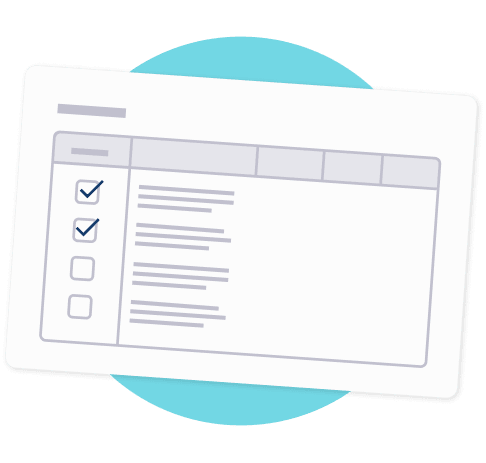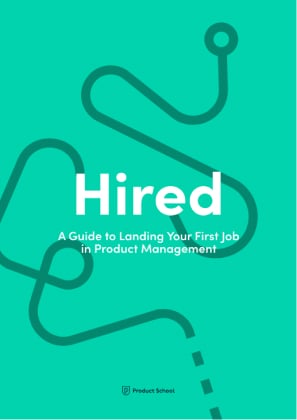Updated: September 27, 2024- 8 min read
Product sense interviews are a part of the selection process at many top tech companies like Meta, Microsoft, Atlassian, and Stripe, among others. They typically evaluate candidates’ ability to come up with creative product solutions on the spot.
If that sounds difficult, it’s because it is. Don’t be discouraged, though. This is a product management interview after all, so it won’t surprise you that the product peers who have gone before you have come up with all types of methods and frameworks to ensure you can provide answers that will impress the interviewer.
In this article, we’ll define product sense and identify the main types of questions interviewers ask to see if a candidate has it. We’ll explain the types of frameworks you can use to come up with great solutions to product sense questions on the spot, plus other tips and resources.
Interview Prep Checklist
Land your dream job with expert-approved example answers and proven frameworks!
GET THE CHECKLIST
What is Product Sense?
Let’s start with the basics. Product sense is the innate ability to understand what makes a product great and how it can meet the market's needs. It involves a deep understanding of users, the competitive landscape, and the ability to innovate within constraints. Product sense is fundamental for Product Managers (PMs) as it enables them to envision products that resonate with users and stand out in the marketplace.
In product sense interviews, candidates are evaluated on their ability to balance user-centric design with viable business strategies. These interviews probe into how candidates identify user needs and translate them into compelling product features. Additionally, they assess a candidate's skill in situating a product within a broader business context, considering market trends, competition, and monetization strategies. The ultimate goal is to gauge the candidate's capability to drive a product's success by aligning user satisfaction with business objectives.
Product Sense Interviewer Expectations
In a product sense interview, interviewers primarily look for a candidate's ability to empathize with users and to innovate within market constraints. They expect candidates to demonstrate deep user understanding, a knack for identifying problems worth solving, and the creativity to devise effective solutions. Interviewers also value clear communication, structured thinking, and a strategic approach to product development.
What interviewers don't expect is perfection in every answer or a one-size-fits-all solution to every problem. They understand the complexities of product management and are more interested in your thought process, problem-solving approach, and ability to pivot based on new information. They don't expect you to have all the answers but to ask the right questions that lead to insightful product decisions.
What to Expect from the Meta Product Sense Interview
The Facebook/Meta product sense interview is well-known in the product management community as the quintessential product sense interview.
In the example above, the product sense interviewee has to imagine herself as a PM at Meta who is tasked with creating a product that will help the company expand into the fitness space.
Her first move is to ask whether this feature will be for Facebook, Instagram, Whatsapp, or another Meta product. Notice that she asks instead of assuming!
In her answer, she’ll relate the idea of fitness and fitness products to Meta’s mission (which she knows going into the interview), its user segments, and their pain points. All this goes into the solutions that she proposes during the interview.
Candidates should be prepared to discuss not only the 'what' and 'how' of a product idea but also the 'why'—the underlying strategy and reasoning. Expect questions that challenge you to think about products at scale, considering both global impact and minute details that enhance user experience.
Examples of Product Sense Interview Questions
Every product sense interview is different, but in general, the product case question involves an open-ended topic that fits into one of the following categoires:
Design
How would you design a product for X target users? For example, how would you design a phone call app for people who are hard of hearing?
Improvement
How would you improve product Y? For example, What would you do to improve a product like Microsoft Teams, or your own favorite product?
Growth
How would you increase revenue for product A? For example, what would you do to generate more revenue from Instagram?
Strategy
Should Bumble try and attract more queer daters?
Launch
What product would you design to help Company A expand into Sector B? As in, what new product would you create to help Meta expand into the fitness space?
Ready to Master The Art of Product Launches?
Get an in-depth understanding of the critical elements that make a launch successful with our free Product Launches Micro-Certification (PRLC)™! Whether you're a seasoned pro or just starting, this is your chance to dive deep into iconic launches, understand foundational elements, and craft exceptional go-to-market plans.
Enroll now for free
Frameworks to Help You Ace the Product Sense Interview
When faced with complex scenarios, break down the problem systematically. Start by clarifying the objectives and constraints. Identify the target user group and their needs, analyze the competitive landscape, and brainstorm potential solutions.
The best way to do this is to use a product sense framework. There are lots of different frameworks that you can use. Practice applying them in your mock interviews to see which ones work best for different types of product cases.
Product Sense Framework Examples
⭕ CIRCLES (Comprehend, Identify, Report, Customers, List solutions, Evaluate trade-offs, Summarize)
The CIRCLES method is a comprehensive framework that can help you answer any of the types of questions above, and it’s particularly well suited for product design questions because it takes you through every step of the design thought process.
⭐ STAR (Situation, Task, Action, Result)
The STAR framework will also help you respond to all of the types of questions you might face in a product sense interview. It is especially useful when it comes to product strategy questions, as it has a focus on results and measuring success.
🚌 BUS (Business objectives, User problems, Solutions)
The BUS framework is a great way to tackle an improvement question as it balances outcomes both for the business and the users.
Tips for Crafting Strong Responses
Frameworks are an essential tool for ensuring your success in a product sense interview as they help you approach any situation with sound logic. However, it’s important to remember that the interviewer is a person, and like all people, will be more amenable to ideas that he or she can visualize and relate to. These tips will help you relate to the product manager on the other side of the table.
Enhancing Your Responses Through Scenario Building
Example question: Design a New Feature for a Food Delivery App
Imagine a scenario where users have complained about not being able to customize menu items. By building a scenario where a user with specific dietary restrictions is trying to order a meal, you can illustrate the need for a more flexible customization feature. This approach not only highlights user empathy but also showcases your solution's direct impact on user satisfaction.
Prioritization and Decision-Making in Product Development
Example: Improving User Engagement for a Social Media Platform
Consider a social media platform like Instagram. To prioritize new features, you might analyze data indicating that users spend significant time viewing stories but have limited interaction options. By deciding to prioritize the development of more interactive story features, like polls or Q&A, you directly address user engagement, demonstrating a data-driven prioritization process.
The Power of Storytelling in Product Sense Interviews
Example: Launching a Health and Fitness App
When discussing the launch strategy for a new health app, craft a story around a user persona—let's say, "Emily," a busy professional striving for a healthier lifestyle but struggling with consistency. Describe how the app's personalized workout and nutrition plans, along with its community support feature, would perfectly fit into Emily's lifestyle, helping her achieve her health goals. This storytelling approach makes your solution relatable and compelling, illustrating a deep understanding of the target user's challenges and needs.
Resources to Help You Prepare for Product Sense Interviews
Building a Strong Foundation: Essential Knowledge for Aspiring Product Managers
There are a few product fundamentals that are sure to come up during the product sense interview. In particular, make sure you brush up on your understanding of :
User personas
Free User Persona Template
Get to know your users to build the right solution for the right audience.
Get Yours Now
Must-Read Books
To deepen your product sense, immerse yourself in the best product books out there. Even better, there are a lot of great books dedicated to the product manager interview process. Check out:
Hired: How to Get a Product Management Job by Product School
Cracking the PM Interview by Gayle Laakmann McDowell and Jackie Bavaro
PS - Co-author Jackie Bavaro did a podcast with us on the sequel, Cracking the PM Career. Check it out!
Decode and Conquer by Lewis Lin
Mock Product Sense Interviews
Do some mock interviews with a product manager you trust or through platforms like Pramp or interviewing.io. These simulated environments help you hone your response strategies and get accustomed to the pressure of real interviews.
Analyzing Product Case Studies for Deeper Insights
Examine successful product case studies to understand what made them stand out. Analyze failed products to learn what went wrong.
If you have experience from a product management course or working as a PM, take a look at your own role in the success or failure of product management endeavors. Chronicle these in a product portfolio. What challenges did you face? What would you do differently? Interviewers love to hear about your real-life experience.
On the day of your interview, if it all gets a little overwhelming, remember, you’ve got this! The fact that you were offered an opportunity to do a product sense interview means you’re already well on your way to becoming a great product manager. You’ve got your frameworks, your storytelling skills, and your love of product with you. You’re gonna ace it!
Download the “Hired” Ebook For Free!
After years of working with and learning from today’s top Product Leaders, we’ve condensed their knowledge into this all-in-one guide to starting your PM career.
By sharing your email, you agree to our Privacy Policy and Terms of Service

Updated: September 27, 2024




